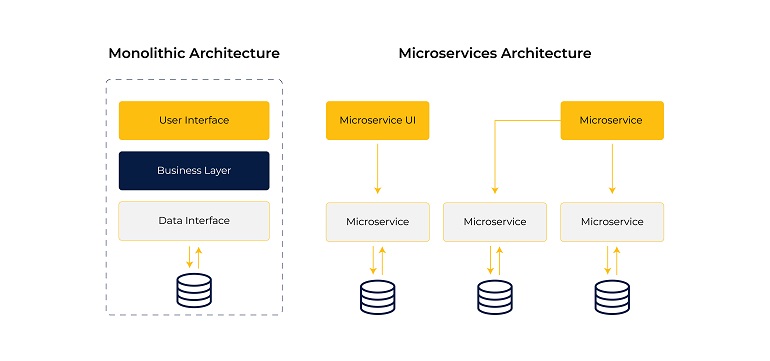We often come across technical terms like full stack development. Interestingly, most of us don’t even know its exact concept and meaning. For the unaware, full stack development is the end-to-end application development process. It includes the front and the back-end development too.
In applications or software, the front-end usually comprises the user interface, whereas all the business logic and app workflow take place in the back-end. To develop a high-performance application, developers require a full stack.
What is Full Stack Development?
Full stack development refers to the practice of developing both front-end (client software) and back-end (server software) parts of a web application. A full stack developer works on an application’s front-end, back-end, debugging, and database.
High-performance web and mobile applications allow users to do many tasks. But how? A website requires both front and back-end logic to provide a wide range of features. The front-end UI and the back-end business logic help carry out these functions. Software developers can also build the website user interface with the help of front-end technologies and use various programming languages for writing the back-end.
Additionally, business logic runs in the back-end, which connects the application to several other data centers and services. For example, an app’s database stores all the customer or user data. These databases include transactional and sensitive customer data in the specific drivers present in the app’s back-end.
In short, a full stack developer takes care of the full stack development of an app that comprises both front and back-end workflow and business logic. The developer single-handedly implements the workflows, such as order placement and profile changing. Let’s learn more about high-performance app development using full stack.
Features of Good Web Apps
So, what are the features of a good web application? A good web app requires scalability, stability, reliability, event handling, and routing. Several libraries or frameworks take care of all these app necessities and characteristics.
Here is a list of features that enable an application to become high performing:
- Quick and easy data discovery
- Increased security of application data
- Flexibility, scalability, and agility
- Mobile-compatible interface
- Social media integration for application login
- Analytics and reporting features
- Push notifications
- Live chat via AI-powered chatbots
- SEO friendly
- Ecommerce features
Modern vs. Monolithic Applications
Let us talk about “How a typical application works.” A standard monolithic application would look like the following: you have a server and a client browser; the browser sends the request to the server, and the server entertains the request by connecting with the database and sending back the response to the client.
This is not a fundamentally sound architecture because you are doing a lot of work on a single machine or server, including front-end, back-end, and database management. It leads to performance, latency, and scalability issues.
 On the other hand, a modern enterprise application consists of various separate layers, i.e., a modern front-end and a robust back-end. It uses a blend of microservices, serverless, and cloud services. In the last few years, enterprises have been migrating from monolithic to adopting modern applications to achieve desired business goals.
On the other hand, a modern enterprise application consists of various separate layers, i.e., a modern front-end and a robust back-end. It uses a blend of microservices, serverless, and cloud services. In the last few years, enterprises have been migrating from monolithic to adopting modern applications to achieve desired business goals.
Xavor’s Full Stack App Development Services
At Xavor, we follow Enterprise-grade development practices for building scalable and high-performance applications. We are highly experienced and trained in requirement analysis. We choose feasible full stack app development option and thereby build modern architecture. Our focus is on implementing security, scalability and high availability. Moreover, we set cloud infrastructure and conduct testing.
But most importantly, we value our customers’ business needs and understand business security compliances like HIPAA for healthcare and developing ADA-compliant websites. We have dynamic expertise in the following:
CMS (Content Management System) & Static Site Generation
Your front-end does not need to be a server every time. It can be a global CDN because, in most cases, your front-end will deliver the static pages, whether those are static pages, server-side generated pages, or server-side rendered pages.
The first result will be served from a CDN when somebody enters your domain, and since the result will be cached, it will be a super-fast delivery to the end user.
SEO friendly
Today, most businesses around the globe are investing in SEO which is search engine optimization. It helps businesses optimize their websites and presence, capturing more traffic and generating more revenue from searches. We at Xavor build SEO-friendly websites and solutions, thus helping our customers succeed.
Mobile-optimized user experience
With so many people using smartphones these days, it has become necessary for the success of your business to have a website that is mobile-optimized in terms of user experience, responsiveness, and performance.
However, setting up the mobile version of the website can be daunting. Thus, it is a job better left for professionals, and that is where we come in. We offer a wide range of services – whether you want to redesign the entire website or make your existing website mobile-friendly – Xavor will do it for you.
Integration with third-party applications
Integration of your application with other third-party applications can be incredibly challenging at times, which takes planning and commitment to modify the flow of your application accordingly.
It needs a detailed analysis of challenges and potential risks. Xavor has implemented various enterprise applications that require integration with others like Kentico, Algolia, Agile PLM, Crunchbase, and others. We make sure to implement all the recommended standards of security for our customers while doing these integrations.
Infrastructure security and governance
Security and governance refer to the ways and processes by which you can control as well as direct the application infrastructure security by mitigating business risks and avoiding data leakage.
We need to ensure that we are reducing the security risks to an acceptable level and yielding the desired outcomes. Our team at Xavor is fully trained to manage and implement the security and governance of the applications, whether on-prem or cloud-enabled applications.
Our Approach
We use a comprehensive approach to application development and delivery, gathering the requirements, developing those, and deploying the application on the DEV. Later, we promote it on the UAT for the customer to verify them. And lastly, we move them to production after incorporating the feedback and verification on UAT.
If you want to develop a high-performance application, feel free to contact us at [email protected].












